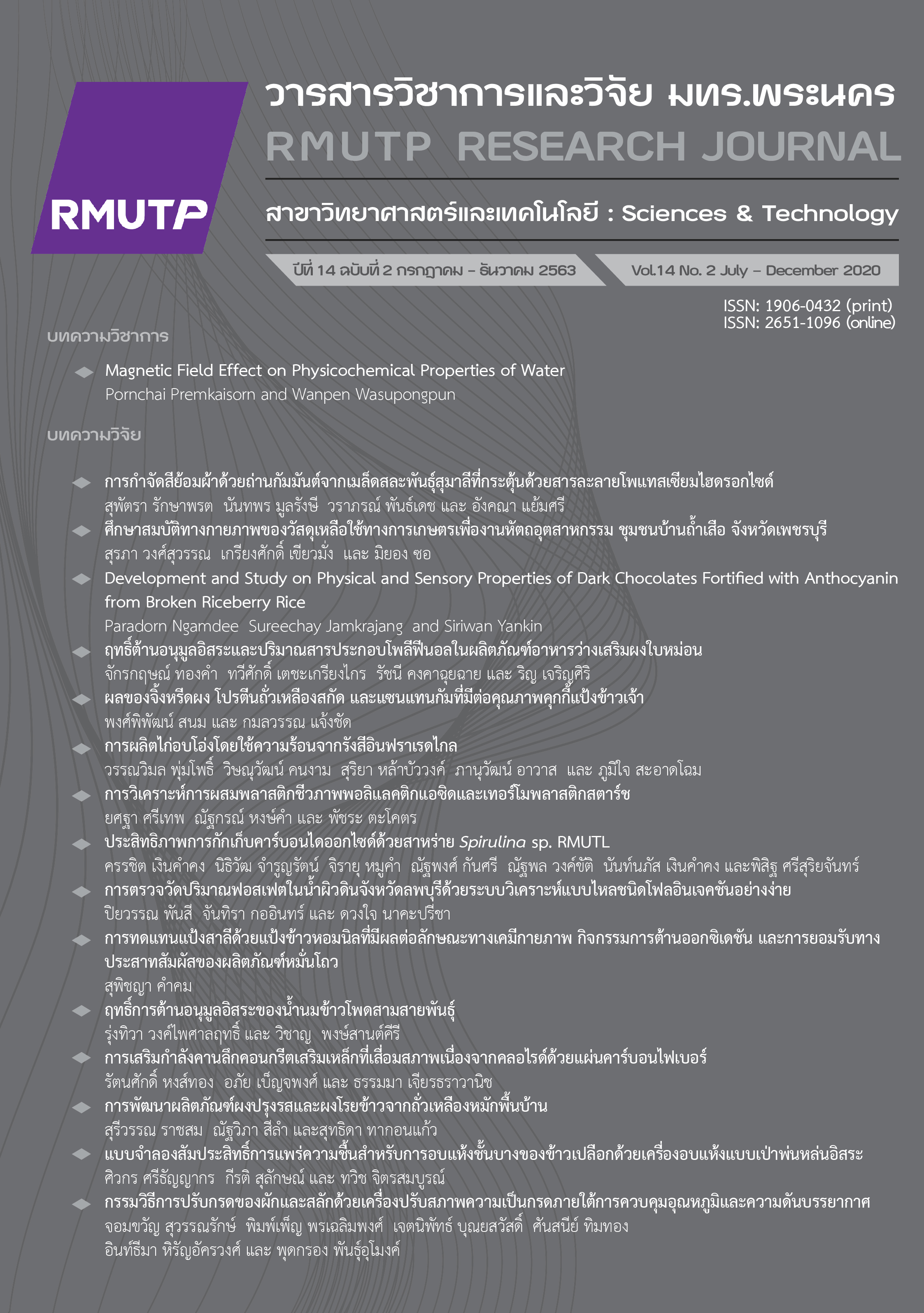แบบจำลองสัมประสิทธิ์การแพร่ความชื้นสำหรับการอบแห้งชั้นบางของข้าวเปลือกด้วยเครื่องอบแห้งแบบเป่าพ่นหล่นอิสระ
Main Article Content
บทคัดย่อ
งานวิจัยนี้พัฒนาแบบจำลองที่ใช้หาค่าสัมประสิทธิ์การแพร่ความชื้นสำหรับการอบแห้งชั้นบางของข้าวเปลือกด้วยเครื่องอบแห้งแบบเป่าพ่นหล่นอิสระในรูปแบบใหม่ โดยออกแบบสร้างเครื่องอบแห้งดังกล่าวเพื่อทดลองผลจลนพลศาสตร์การอบแห้ง ภายใต้เงื่อนไขอิทธิพลของอุณหภูมิลมร้อนในช่วง 60-150 องศาเซลเซียส มวลข้าวเปลือกเริ่มต้น 5-15 กิโลกรัม และความเร็วลมร้อน 19 เมตรต่อวินาที ผลแสดงให้เห็นว่าอุณหภูมิลมร้อนสูงขึ้นและมวลข้าวเปลือกเริ่มต้นลดลงส่งผลให้เวลาอบแห้งลดลงอย่างมีนัยสำคัญ ผลการทดลองถูกนำไปใช้สอบเทียบแบบจำลองการอบแห้งชั้นบางที่นิยมใช้กันอย่างแพร่หลาย 12 แบบจำลอง เพื่อหาแบบจำลองที่เหมาะสม โดยพิจารณาจากค่ารากที่สองของความคลาดเคลื่อนกำลังสองเฉลี่ย (RMSE) ค่าไคกำลังสอง (χ2) และค่าสัมประสิทธิ์สหสัมพันธ์ (r) เมื่อพิจารณาทั้งอิทธิพลของอุณหภูมิลมร้อนและมวลข้าวเปลือกเริ่มต้น ในรูปแบบเชิงเส้นพบว่าแบบจำลองอบแห้งชั้นบางที่นิยมใช้สามารถทำนายผลของอัตราส่วนความชื้นได้แม่นยำ โดยให้ความแม่นยำสูงสุดที่ RMSE=0.0279 χ2=0.00084 และ r=0.9938 นอกจากนี้ผลการทดลองยังถูกนำไปใช้สังเคราะห์หาสัมประสิทธิ์การแพร่ความชื้นในรูปแบบใหม่ที่เป็นฟังก์ชันของมวลข้าวเปลือกเริ่มต้น อุณหภูมิลมร้อน และเวลาอบแห้ง แบบจำลองที่พัฒนาขึ้นอยู่ในรูปฟังก์ชันเอกซ์โพเนนเชียลที่ประกอบด้วยค่าคงที่แบบจำลองเพียงจำนวน 7 ตัว เมื่อนำไปใช้จำลองผลอัตราส่วนความชื้น พบว่าให้ความแม่นยำเทียบเท่าแบบจำลองที่นิยมใช้ที่แม่นยำสูงสุด ซึ่งใช้ค่าคงที่แบบจำลองถึง 24 ตัว โดยให้ค่าความแตกต่างของผลจำลองเพียงร้อยละ 1.8
Article Details
References
P. Thongma, "Paddy Drying by Spouted Bed Technique for Industrial Scale," M.S. thesis, Dept., Energy Tech., King Mongkut’s University of Technology Thonburi, Bangkok, Thailand, 1999.
P. Praneetpolkrang and K. Sathapornprasath, “Application of a Combined Jet Spouted Bed and Ultrasound Waves for Drying of Agricultural Products,” Srinakharinwirot Engineering Journal, vol. 12, no. 1, pp. 163-175, 2017.
S. Meesukchaosumran and T. Chitsomboon, “Effects of resting periods, air temperatures and air velocities on free-fall paddy dryer performances,” Suranaree Journal of Science and Technology, vol. 25, no. 1, pp. 11-26, Jan. 2018.
S. Khaengkarn, S. Meesukchaosumran and T. Chitsomboon, “Genetic algorithm for the selection of rough rice drying model for the free-fall paddy dryer,” Journal of Research and Applications in Mechanical Engineering, vol. 1, no. 1, pp. 63-75, 2011.
C. J. Lim and J. R. Grace, "Spouted bed hydrodynamics in a 0.91 m diameter vessel," The Canadian Journal of Chemical Engineering, vol. 65, no. 3, pp. 366-372, 1987.
N. Epstein and J. R. Grace, Spouted and Spout-Fluid Beds: Fundamentals and Applications, 1st ed. New York: Cambridge University Press, 2011.
M. J. San José, M. Olazar, R. Llamosas, M. A. Izquierdo and J. Bilbao, “Study of dead zone and spout diameter in shallow spouted beds of cylindrical geometry,” The Chemical Engineering Journal and the Biochemical Engineering Journal, vol. 64, no. 3, pp. 353-359, 1996.
S. Jongjam and U. Teeboonma, “Murdannia Lorifomis Drying Using Infrared-vacuum Technique,” Journal of Science & Technology, Ubon Ratchathani University, vol. 12, no. 3, pp. 75-85, 2010.
O. A. Aregbesola, B. S. Ogunsina, A. E. Sofolahan and N. N. Chime, “Mathematical modeling of thin layer drying characteristics of dika (Irvingia gabonensis) nuts and kernels,” Nigerian Food Journal, vol. 33, no. 1, pp. 83-89, Jun. 2015.
I. Alibas, “Selection of the Best Suitable Thin-Layer Drying Mathematical Model for Vacuum Dried Red Chili Pepper,” Journal of Biological and Environmental Sciences, vol. 6, pp. 161-170, Jan. 2012.
H. M. THAO and A NOOMHORM, “Modeling and effects of various drying methods on sweet potato starch properties,” Walailak Journal of Science and Technology, vol. 8, pp. 139-158, 2011.
N. Kumar, B. C. Sarkar and H. K. Sharma, “Mathematical modelling of thin layer hot air drying of carrot pomace,” Journal of food science and technology, vol. 49, no. 1, pp. 33-41, 2012.
J. Zhang, P. Ma, X. Zhang, B. Wang, J. Wu and X. Xing, “Isothermal drying kinetics of paddy using thermogravimetric analysis,” Journal of Thermal Analysis and Calorimetry, vol. 134, no. 3, pp. 2359-2365, Dec. 2018.
S. Mujaffar and S. John, “Thin-layer drying behavior of West Indian lemongrass (Cymbopogan citratus) leaves,” Food Science & Nutrition, Report no. 4, p. 1085, 2018.
C. L. Hii, C. L. Law and M. Cloke, “Modeling using a new thin layer drying model and product quality of cocoa,” Journal of Food Engineering, vol. 90, no. 2, pp. 191-198, Jan. 2009.
M. Özdemir and Y. Onur Devres, “The thin layer drying characteristics of hazelnuts during roasting,” Journal of Food Engineering, vol. 42, no. 4, pp. 225-233, Jan. 1999.
G. K. Jayatunga and B. M. W. P. K. Amarasinghe, “Drying kinetics, quality and moisture diffusivity of spouted bed dried Sri Lankan black pepper,” Journal of Food Engineering, vol. 263, pp. 38-45, 2019.
O. Hacihafizoğlu, A. Cihan, K. Kahveci and A. G. B. de Lima, “A liquid diffusion model for thin-layer drying of rough rice,” European Food Research and Technology, vol. 226, no. 4, pp. 787-793, 2008.
L. N. Kahyaoglu, S. Sahin and G. Sumnu, “Spouted bed and microwave-assisted spouted bed drying of parboiled wheat,” Food and Bioproducts Processing, vol. 90, no. 2, pp. 301-308, 2012.
M. Khanali, A. Banisharif and S. Rafiee, “Modeling of moisture diffusivity, activation energy and energy consumption in fluidized bed drying of rough rice,” Heat and Mass Transfer, vol. 52, no. 11, pp. 2541-2549, 2016.
D. I. Onwude, N. Hashim, R. B. Janius, N. M. Nawi and K. Abdan, “Modeling the Thin-Layer Drying of Fruits and Vegetables: A Review,” Comprehensive Reviews in Food Science and Food Safety, vol. 15, no. 3, pp. 599-618, 2016.
Z. Erbay and F. Icier, “A Review of Thin Layer Drying of Foods: Theory, Modeling, and Experimental Results,” Critical reviews in food science and nutrition, vol. 50, pp. 441-464, 2010.

